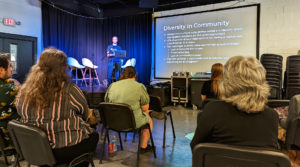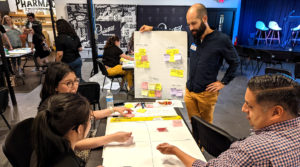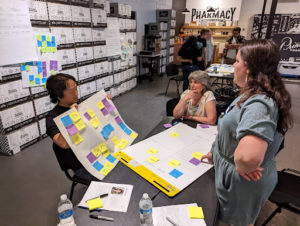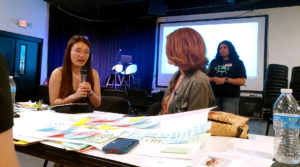It comes as no surprise to many that the design industry in the U.S. does not accurately reflect the diversity of this country in terms of race, ethnicity, gender identity, sexual orientation, disability, and many other factors. But did you know that as of 2019 – thirty years after the first AIGA Design Census highlighted the fact that the design industry was 93% white – non-white designers still only make up 27% of the industry? This lack of diversity is a result of the design industry being slow to change to reflect the diversity of the U.S. population. But how can design studios and the design industry as a whole increase their diversity?
AIGA DFW’s Path to Impact workshop
At a recent AIGA DFW workshop focused on Diversity in Design, I helped lead a breakout group through design thinking exercises as participants learned the Path to Impact framework. Path to Impact is a five-step framework that helps designers have a positive impact through design by teaching users to always work with a specific beneficiary in mind, stay inclusive throughout the process, have measurable courses of action, and consider any consequences of your decisions. The workshop was led by Gage Mitchell (he/him), co-creator of the Path to Impact framework, former President’s Council Chair for AIGA as well as the Principal and Creative Director at Modern Species, a strategic branding and responsible design studio in Seattle, Washington. I am grateful for his time and effort in making this workshop a reality.

The state of diversity in design
The workshop was formatted into two parts, with the first being a brief presentation introducing participants to the Path to Impact framework and the state of diversity in the design field in four areas of focus: education, workplace, those impacted by design, and community. During this time, my co-facilitators and I also shared statistics such as the ones mentioned at the beginning of this article. I presented on the topic of diversity in the design workplace, including statistics like the fact that 53.4% of designers are women, yet men are still overrepresented in leadership positions – with only 11% of women designers holding leadership positions.1
Breakout sessions: envisioning our impact
Afterwards, participants broke out into smaller groups to experience the process themselves by working through the first step of the framework: Envision. During this breakout session, participants worked with an imaginary beneficiary. My group had the profile of a design agency co-owner, Alexandra, who valued diversity in her field and wanted to ensure she had a wide-ranging pool of applicants and employees.
Through the process of brainstorming about the problems Alexandra was facing, the desired outcome, and potential ways to get to these outcomes, our group came up with the following activities that Alexandra would need to commit to in order to interview and hire more diverse candidates for her company. These activities and our discussions around them offer valuable insights for all design organizations that want to emphasize the importance of diversity and improve their hiring practices.

1. Educate current employees and stakeholders
In order to emphasize the importance of diversity and improve their hiring practices, Alexandra’s company must educate employees and especially those stakeholders who are in hiring roles. The hiring process and the selection of a final candidate can be influenced by the perspective and biases of the hiring manager. My group came to this conclusion through discussing our own experiences with the hiring process, including several members of our group who were students and had experience interviewing for internship positions.
One example a member of my group brought up was a hiring manager who had only ever used a personal vehicle to commute might not understand the struggles faced by a candidate who relies on public transportation to come to work. However, we agreed that whether or not a candidate has a car does not influence the quality of their design work or the unique perspectives they could bring to Alexandra’s company.

2. Emphasize the importance of diversity to the field of design
Another concept we discussed was that even lower level employees who are not in a position to interview or hire new employees should be brought into conversations about the importance of diversity in the design workplace. One workshop participant shared how she had been in environments where the higher-up employees understand the importance of diversity in design, but her fellow workers did not seem to have been exposed to this concept.
An example we came up with was how an employee who went to a traditional, four-year, predominantly white design school in the U.S. might have different visual tastes then an employee who grew up in Indonesia and was exposed to different design movements during their education at a 2-year design program. However, both employees bring valuable contributions and unique visual styles to the table at Alexandra’s company and neither educational or cultural background nor visual style should be considered to be the default or the more correct way to approach design.

3. Make sure there will be a welcoming environment for any new hires.
Finally, we discussed that ensuring the work environment is welcoming to new employees is essential to Alexandra’s goals. Alexandra’s company is off to a good start if current employees (including stakeholders and lower-level employees) are educated and shown the importance of diversity in the industry. However, if a new employee is hired and they don’t feel welcomed at the company, then it may have been for nothing. An unwelcome employee may end up having a short tenure at the company.
It is likely that we have all had experiences in a work or school environment that made us feel unwelcome or undervalued and are familiar with the feelings this can bring up. By making an effort to welcome new employees and show that their work and perspectives are valued, Alexandra’s company will be well on their way to diversifying their talent pool.

Our conclusions
These three activities all support my group’s main conclusion and the concept we chose to share with the rest of the workshop attendees at the end of the breakout session – that if a company wants to interview and hire more diverse employees, there must first be an internal cultural shift that takes place. This ensures that any interview candidates and potential employees are able to see this as a company that values every employee and their unique perspectives. It makes the company more attractive to candidates from different backgrounds, tying into the idea emphasized by the Path to Impact framework that you must always design with a specific beneficiary in mind – in this case, those who have traditionally been underrepresented in the Western design community.
One of the biggest points Gage taught during the workshop was that good design requires context, and that it was important to keep one’s beneficiaries in mind when designing for good. If a design organization wants to hire more diverse employees, they must start with understanding that they already are designing for a diverse population, and it is up to them to reflect this in their values.
Additional resources
If you’d like to learn more about using design to make a positive impact on your community, AIGA DFW has Path to Impact workbooks available for purchase online at https://dallas.aiga.org/shop/.
Sources:
- Data USA – https://datausa.io/profile/soc/designers
- AIGA x Google 2019 Design Census – www.typeroom.eu/article/automation-threat-gender-pay-gap-evident-2019-aiga-design-census-reveals